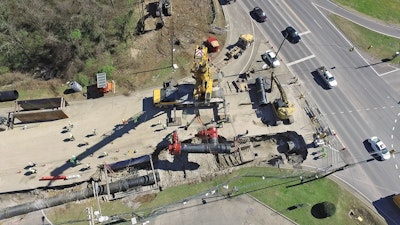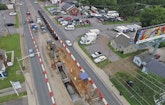
Interested in Inspection?
Get Inspection articles, news and videos right in your inbox! Sign up now.
Inspection + Get AlertsIn the Nashville, Tennessee, airport district, construction of any kind is difficult, let alone installing 5 miles of large-diameter transmission main under two state highways on a tight timeline.
The project included six months of preparatory public outreach, carefully orchestrated construction, and 24/7 work schedules to minimize traffic disruption and inconvenience to customers and local businesses.
A complex system
Metro Water Services is centered in Nashville, but it also serves most of Davidson County and portions of surrounding counties. Over the years, it has incorporated several smaller utilities, including the Cumberland district — the main focus of this transmission water main project. The new water main will provide redundancy and additional capacity in that area.
The utility operates two water treatment plants: K.R. Harrington, the newest plant built in the 1970s, and Omohundro, which dates back to the late 1800s. The distribution system, which serves 198,000 customers, includes 3,000 miles of pressurized water mains, 43 reservoirs, 56 pump stations, and, 20,855 fire hydrants.
Most of the original water system was built with cast iron pipe. Due to nonaggressive soils, it has in most cases lasted well past its expected lifespan. The original treatment plant from 1889 is still online, and much of the pipe predates even that.
For new projects, the utility is using ductile iron, which provides the durability of cast iron with additional corrosion protection, as well as higher pressure and surge ratings.
“They’re ductile in the sense that they can take some subsurface movement and the joints can take some deflection. It’s more forgiving when the ground moves, and also, the pressure rating on the pipes are pretty high,” says Cyrus Toosi, P.E., assistant director and chief engineer of Metro Water Services. “We have basically stuck with ductile iron pipe for our water distribution system.
“I don’t know of any situation — and I’ve been with the utility now for 27 years — that we’ve had a natural break of a ductile iron pipe.”
The master plan
The transmission main project is just one part of the water utility’s master growth plan and is a result of a distribution-system optimization analysis, which found need for added resiliency and redundancy.
“As Nashville grows, we cannot wait until we realize that growth, so we work with the city’s planning commission and metro planning organization, and forecast growth and demands,” Toosi says.
“We have hydraulic models. It says if this area is going to realize a 30 percent growth in the next 10 years, what does that do to flows and pressures in the system?” Toosi says. “We can have a bottleneck in the distribution system and not have it in the treatment plant, so we’ve got to make sure that not only the treatment plant can treat the future growth and send it out from its high-service pumps, but that the distribution system, reservoirs and pumping stations can handle it as well.”
Through further analysis, the utility determined that the best, most efficient route for the new transmission main would run underneath parts of two major roadways.
“These are state highways. The Tennessee Department of Transportation made sure we did a routing study, so we looked at costs, maintenance, and then ultimately water quality,” Toosi says. “The current route was the best solution considering all the factors.”
The water main project came more than a decade after it was added to the master plan and capital improvements budget. Originally, it was slotted as a 24-inch line addition, but after the project was delayed due to more pressing system work, they realized there was a bigger need for a large-diameter redundancy main from the K.R. Harrington plant.
“Part of the reason originally for doing the 24-inch line — that later got combined into this bigger project — was to have an alternative feed into the Cumberland area but also as a reverse alternative feed back to our main distribution system,” Toosi says.
Essentially, they were looking to provide backup distribution capacity going both ways — toward the Cumberland (or east side area) and in return to the main distribution system and the K.R. Harrington plant.
A portion of the existing system is made of 60-inch prestressed concrete cylinder pipe with a history of failures. A recent break in the main disrupted service for customers in the area was a driving factor in changing the project to its current framework.
They expanded the original 24-inch-diameter segment to 36 inch and added a 60-inch line. Despite increased construction, utility officials are glad they waited.
“In hindsight, having delayed the original project actually saved us some money in being able to build both projects together,” Toosi says. “The master plan is ongoing — it’s always updated, it’s always tweaked — because one thing about population projection is it doesn’t always happen exactly as projected.”
Working nonstop
Pressure from the Tennessee Department of Transportation and the potential for public impact complicated the project’s execution. As a result, the utility set an ambitious goal: Complete the 5-mile project in less than a year.
Much of the burden of completing the project on that tight timeline fell on contractor Garney Construction.
“The original goal was for them to work 24/7: the Tennessee Department of Transportation wanted us in and out as fast as we could,” Toosi says.
Unfortunately, that didn’t work out entirely as planned. The project segment on Elm Hill Pike, the only nonhighway portion, presented problems. The area is a popular location for hotels, and neither management nor their guests were thrilled with major construction occurring outside their doors all through the night.
“We had to relax a little bit from that schedule. … People in the hotel were having issues with that, so we relaxed it a little bit there.”
Time, however, remains of the essence. Nearly 4 of the 5 miles of pipe will run next to or directly underneath state highways — for most of the 60 inch and all of the 36 inch. It will tie into a pre-existing 60-inch pipe on the south end, and extend east for about 1 mile along Elm Hill Pike before turning to follow Highway 255. North another mile or so, it transitions into 36-inch main, following Highway 70 for 2 1/2 miles.
In many cases, the project will involve tearing up two lanes of the four-lane highways. Traffic control and coordination is a big challenge, and so far, Metro Water Services officials say the contractor has done a great job finding creative solutions, even garnering praise from the public.
Despite issues with public impact and work schedule changes, Metro Water Services is on track to complete the project by the end of 2017.
“We’re on schedule even though we’ve had to lax a little bit of the 24/7 — but the 24/7 was originally intended for us to get in there and get out as soon as we could … and that’s something the public probably appreciates as well.”
Public buy-in
Before construction crews ever moved the first bucket of dirt, Metro Water Services staff spent six months setting the stage with a public outreach campaign.
“I think with the realization that we had to do this project, getting our stakeholder’s buy-in was a big challenge,” Toosi says.
The utility spent six months going door to door and holding community meetings to educate people on logistics of the project and why it was needed.
“We wanted to — well in advance of the project — let everyone in the community understand this is not just a quick, easy, we’re going to dig a trench, put a little waterline in,” says Sonia Allman, manager of strategic communications for Metro Water Services.
Difficulties of construction and extraordinary time constraints aside, Toosi and Allman say the public outreach was one of their biggest challenges.
“We worked very closely with the community,” Allman says. “There have been a lot of hands on deck and a lot of communication. … That all began in 2016, well in advance of the project beginning.”
A never-ending story
The water main addition is just one piece of an eternal puzzle — there’s always another project, another goal — but Metro Water Services officials believe they are where they need to be.
“We’d like to have at least two feeds coming out of (K.R. Harrington) for ultimate redundancy; we realize we can’t bite the bullet and do everything at once,” Toosi says. “But it’s positioning us to do another project in the future, to continue getting redundancy and capacity in our system.”
No sugarcoating
As part of the expansive public outreach conducted by Metro Water Services, a little creativity went a long way in showing citizens what the project would entail.
“We talk about water projects and people are like, ‘Oh yeah, I’ve seen water projects before; OK, so they’re going to put a waterline in here,’” says Sonia Allman, manager of strategic communications for Metro Water Services. “Very few people have ever seen a 60-inch water main, and they have a hard time visualizing what that looks like and the construction associated with it.”
So the utility found a creative way to demonstrate what it meant to embark on such a large project with a somewhat paradoxical makeover of a construction material.
“One thing we did very different with this project is we actually had a piece of 60-inch pipe decorated like a candy cane in the Donelson Hermitage Christmas Parade,” Allman says. “We didn’t want to sugarcoat (the project). It is going to be major construction. There are going to be headaches. There are going to be traffic issues. … Being in the Christmas parade, people knew what we were doing, why we were doing it, and what that process looks like.”








